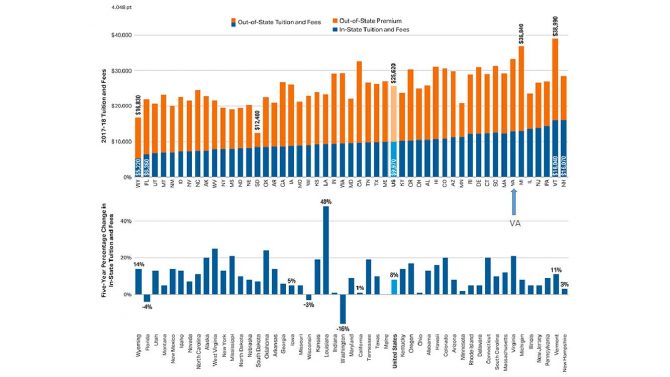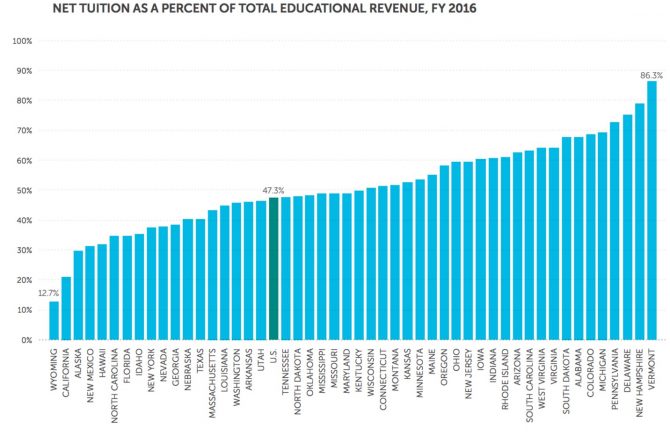I appreciated the opportunity Tuesday to speak to the Virginia Senate Finance Committee about the accomplishments and needs of our public universities. I started by thanking the committee for the support received in recent years by the General Assembly to higher education, including major investments in capital projects, salaries, financial aid, and research.
The rest of my presentation covered the following:
1. Virginia public universities are doing a great job of educating students compared to other states.
a. We have been recognized as the #1 system of higher education in the nation in terms of return on investment to students and graduation rates (see SmartAsset).
b. Four of our universities are ranked among the top 150 national universities by U.S. News & World Report (UVA, WM, VT and Mason). Three (WM, VT and Mason) were listed by U.S. News among the 25 most efficient in terms of achieving ranking bang for the invested buck.
c. With the addition of Mason, we now have four “Very High Research” universities, a Carnegie classification assigned to only 115 universities nationwide (the other Virginia institutions are VT, UVA and VCU).
d. Three Virginia universities are ranked among the Top 300 in the world by the Academic Ranking of World Universities (UVA, Mason, VCU).
e. Our universities continue to grow, delivering on the goal of Virginia becoming the best-educated state. Last year we added 1,879 students. Mason (with 1,072), VT and JMU were the largest contributors.
f. Very importantly, our graduates show one of the lowest student loan default rates in the country (see graph above), a clear sign of the value of a degree from our universities.

g. Virginians are proud of their universities, with polls showing an overwhelming 84 percent of Republicans and 94 percent of Democrats agreeing that our institutions are valuable assets for the state, well run, and a wise investment of public dollars.
h. Universities annually bring $1.4 billion in research grants from outside the Commonwealth (mostly from federal grants) and $900 million in tuition from out-of-state students. This $2.3 billion is one of the greatest sources of exports in the state economy.
2. The one area where we need to do better is in research funding.
On a per-capita basis, we trail the national average and neighboring states of comparable size (Georgia, North Carolina) in external research funding. We needed a concerted effort to invest in strategic areas and build capabilities to compete for large research grants at the federal level.
3. Data show that Virginia has above-average in-state tuition and below-average per-student tax appropriations.
Our overall per-student revenues and expenditures are on par with the national average. In other words, Virginia in-state tuition is where you would expect it to be given our public investment.
a. Universities are committed to keeping tuition as low as possible, but it would not be wise to try to become a “low tuition – low appropriation” state. That would threaten the excellent value we currently provide to students.
b. While we remain a low-appropriation, high-tuition state, investments in financial aid remain critical to maintain low student default rates and high student ROI for low-income students.
Source: State Higher Education Executive Officers
Source: College Board
4. Our colleges and universities are committed to delivering even more value to the Commonwealth by:
a. Establishing new collaborations with business to create internships and apprenticeships, and to align curriculum with areas of critical need.
b. Sustaining efforts to continue enrollment growth to become “the best-educated state” (State Council of Higher Education for Virginia goal) and produce an additional 100,000 graduates by 2025 (Top Jobs for the 21st Century legislation). Last year we added 1,879 students (1,072 at Mason, 599 at VT, 401 at JMU).
c. Strengthening collaboration between community colleges and universities to facilitate transfers and create pathways to degrees in critical areas for the economy (example, the ADVANCE program between Northern Virginia Community College and Mason, the largest transfer pipeline in the stat).
d. Leading regional economic development efforts through business incubation and workforce development programs and participation in programs such as GO Virginia.
e. Leveraging online technology to offer more opportunities to adult learners.
f. Producing more research, especially in areas of strategic importance to the Commonwealth.
5. Our colleges and universities would benefit significantly from the Commonwealth through:
a. Stable, predictable funding. Even if we remain a low-appropriation high-tuition state, predictability of public funding would help us plan our growth more strategically.
b. Financial aid remains a top priority, especially for institutions serving high-need students.
c. Salary competitiveness remains an important issue for most of our universities, which find it challenging to retain faculty.
d. Additional funding of the Virginia Research Investment Fund would significantly contribute to increasing our capacity to attract major federal research grants. The recent study about strategic areas of opportunity marks the way forward.
e. Continuing support for the autonomy and singularity of each of our universities will be essential. Virginia is blessed with a system that grants significant autonomy to our universities and we must do everything possible to preserve that.



